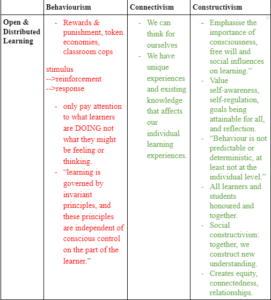How would you describe the historical and theoretical trends in k-12 open and distributed learning?
After annotating the course readings this week and watching the video lecture, I have learned a lot about the historical and theoretical trends in k-12 open and distributed learning. In addition to the history of distributed and open learning, topic two has also helped solidify my understanding of what these terms themselves mean:
- Open Learning is described as a way to remove or weaken the barriers, thus opening up learning possibilities that previously were not possible (Roberts et al., 2018, p. 528).
 It is also an “intentional design” that builds up learning opportunities for ALL learners (Roberts, 2020). These opportunities transcend cultures and the walls of the classroom through “alternative modes of learning,” “collaboration,” “knowledge sharing,” and “networked participation” (Roberts, 2020). For example, open learning is more than just a field trip or making connections with students/their guardians: it means project-based learning, blogs, penpals, etc (Roberts, 2020).
It is also an “intentional design” that builds up learning opportunities for ALL learners (Roberts, 2020). These opportunities transcend cultures and the walls of the classroom through “alternative modes of learning,” “collaboration,” “knowledge sharing,” and “networked participation” (Roberts, 2020). For example, open learning is more than just a field trip or making connections with students/their guardians: it means project-based learning, blogs, penpals, etc (Roberts, 2020). - In British Columbia, Distributed Learning is described as a digital medium that allows for “an increase of student access, choice, and flexibility for study outside of classroom schedules” (Roberts, 2020). In BC, this definition relies heavily on the specific context of learning while also including e-learning and online learning (Roberts, 2020).
Topic Two has taught me that in Canada, while traditional schools are run by Provincial Ministries of Education and funding is provided by taxes, e-learning/distance education/online/blended learning often has its own unique set of rules depending on location (Barbour & Labonte, 2018, p.602). Both the first Canadian correspondence school and the first technology-supported e-learning system got their start in BC (Barbour & Labonte, 2018, p.602). Over time and thanks to growing digital educational technologies and the computer revolution, open learning has become a term to describe flexible learning or asynchronous learning. Over the years, BC has created many standards and policies to help manage the growing demand for both online and open learning. In BC, “COOL School” was a consortium formed between four school districts to share a learning management system; it later led to a BC/Yukon wide network “committed to supporting e-learning programs for both fully online and classroom-based blended learning” (Barbour & Labonte, 2018, p.608-609). BC has been a leader in Canada for its educational involvement in creating successful e-learning programs, as seen by its student enrollment rate (the highest in Canada proportionally) (Barbour & Labonte, 2018, p.603). To be successful, it has been found that e-learning programs need “initial investments in digital resources,” “instructional design for effective deployment of these resources,” “technological infrastructure for delivery,” and skilled teachers (Barbour & Labonte, 2018, p.609).
Since there has been confusion about what constitutes open learning and what does not, the eight principles of open learning were created (Roberts et al, 2018, p.529). They are the following:
(1) learner-centeredness;
(2) lifelong learning;
(3) flexibility in learning;
(4)removal of barriers to access;
(5) recognition of prior learning experiences and current competencies;
(6) learner support;
(7) expectations of success;
(8) and cost-effectiveness. p.529

Changes to educational curriculums across the world have spurred “calls to develop digital fluency, and to become more personalized, flexible, and adaptable to individual learner’s needs” (Roberts et al., 2018, p.527). We as educators must learn how to keep meeting our learner’s needs despite changes within our communities from local to global. The article by Roberts et al. demonstrates the fact that many people see the term Open Education and only focus on new digital technologies; however, these people fail to see the importance of teaching with the learner-centered model that open education emphasizes.
The opening up of learning is supported by many educational theorists such as Dewey, Vygotsky, Pacquette, and Friere who believed in the idea that knowledge should be free and open to use and re-use (Roberts et al., 2018, p. 528-530). Open pedagogy became more well known in Canada in the 1970s and was based on Paquette’s notion of the interrelatedness of “the physical layout of the classroom, the learning activities, and the teacher interventions” (Roberts et al., 2018, p.529). He and the other three aforementioned researchers “questioned the privilege, limited access and freedoms inherent within the status quo of the reigning educational system, and thereby sought liberty, choice and becoming a voice for change” (Roberts et al., 2018, p.529). By creating Open Education Resources, these ideas help to create collaborative learning cultures to “encourage the building and sharing of knowledge” (Roberts et al, 2018, p.531).

Here is a table I made based on what I learned from all three articles this week. It shows which learning theories align well with open and distributed learning (green) and which do not (red).
After reflecting on this week’s readings, I believe that while research on Open and Distributed Learning has led us in the right direction of opening up schools and curriculum, more research must be done. For now, it is up to educators to put the ideas of open and distributed learning to the test in the classroom and find out what works best for certain learners.
References
Barbour, M & Labonte, R. (2018) An Overview of eLearning Organizations and Practices in Canada. In R. Ferdig & K. Kennedy (Eds.), Handbook of research on K-12 online and blended learning (pp. 600-616). Pittsburgh, PA: Carnegie Mellon University ETC Press.
Bates, T. (2014). Learning Theories and Online Learning. [Blog post]. Retrieved from https://www.tonybates.ca/2014/07/29/learning-theories -and-online-learning/.
Flipped Learning Network. Definition of Flipped Learning. Retrieved from https://flippedlearning.org/definition-of-flipped-learning/
Roberts, V., Blomgren, C. Ishmael, K. & Graham, L. (2018) Open Educational Practices in K-12 Online and Blended Learning Environments. In R. Ferdig & K.Kennedy (Eds.), Handbook of research on K-12 online and blended learning (pp. 527–544). Pittsburgh, PA: Carnegie Mellon University ETC Press.
Roberts, V. (2020). Topic 2 EDCIA04 [Video]. Retrieved from https://www.youtube.com/watch?v=B3Nek-T4vFw

laurenmclean
Feedback for EDCI 339:
Your blog post gave a real comprehensive analysis of the articles. I particularly enjoyed how you made a table outlining all of the different teaching styles to display your learning. I also liked how you talked about the evolution of e-learning and how it has adapted to the ever evolving climate and how you highlighted the idea of learner-centered model within open education. If you were to amend this post I may have arranged the post differently. I felt that you had moved on from the history of open education and then came back to it when talking about the theorists. This could just be personal preference! Overall, a beautiful post!
hgus123
EDCI 339 Feedback:
Sarah, I thought your blog this week was very insightful and showed a clear understanding of the theoretical and historical backgrounds of education and distributed/open learning. I thought it was so creative to create a chart of the major theories and list their key points. I loved how you colour-coded the ones you align with in green and the ones you disagree with in red. This clearly shows the reader how you value the educational theories and your perspective on teaching. One way you could enhance your chart is by also including a section on cognitivism. Also, part of the question asks about what you want to know and what you still have questions about. Consider adding this in (word count permitted). Fantastic job this week!
alexamclean
Feedback for EDCI 339:
This was a very good post. I found it super clear and concise and you did a good job of balancing evidence from the readings and using your own words. One thing that would make the post even better would be to keep the open education sections together and transition to how it relates to distributed learning in Canada. I think they both have separate histories that need to be highlighted, but there are parts that overlap. I really enjoyed your table of the different theories, it was an out of the box idea that I may add to my future posts! I also liked that you began with a clear definition of both open and distributed learning. Great post, I look forward to reading your next one!